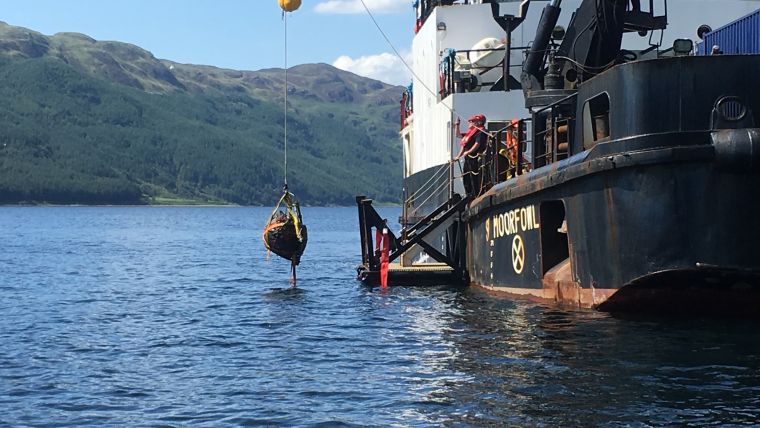‘Bouncing Bombs’ Located in Scottish Loch
A Klein 4900 high-definition sidescan sonar has been used to locate and identify WW2 ‘bouncing bombs’ in a Scottish loch. GSE Rentals, part of Unique System UK, provided the scanning equipment and engineering support to produce sonar images of the seabed at the dive site currently being explored by the British Sub-Aqua Club (BSAC). The iconic Highball bombs were recovered in perfect condition by divers, thanks to the technical input from Unique Group.
The scanner was pulled by a workboat from fellow Scottish company Aspect Surveys. Sub Sea Tooling Services based near Aberdeen also provided an underwater ROV (Remotely Operated Vehicle) to assist with filming the searches. The bombs, which are inactive, were secured by the divers ready for lifting by the Royal Navy and then winched to the surface before being packed, ready for transport in wet tanks containing a special salt-water solution to prevent them from corroding.
Use of the Bouncing Bombs
The scuba divers have completed a daring mission to raise two historic, ‘Highball’ bouncing bombs like those used by the Dambusters squadron on the successful raid of the Eder Dam. Footage of the Highball bombs being tested was used in the World War II film classic, The Dambusters. The Highballs were the naval or anti-ship version of the cylindrical shaped Upkeep bouncing bombs which were used by the Royal Air Force in the actual Dambusters raid in May 1943, both having been designed by Sir Barnes Wallis to bounce over water. However, it is archive footage of the Highballs being tested at Loch Striven which feature in the 1955 ‘The Dam Busters’ film, as footage of the actual dams bomb used by the RAF was still top secret. More than 200 of the bombs, codenamed Highball by the military, were tested at Loch Striven. They were intended to be used on enemy ships but never became operational and they lay scattered on the floor of the loch for three-quarters of a century. The project has received backing from Mary Stopes-Roe the daughter of late British engineer, Sir Barnes Wallis, who invented Britain’s bouncing bombs including the Highballs.
Around 200 Highballs have lain at the bottom of Loch Striven in Argyll, for almost 75 years since they were tested by the Royal Navy for use against enemy ships and for the Eder Dam raid in the Second World War.
Now the aim is to donate the Highballs to two museums so they can be put on display to the public, in time for the 75th anniversary of the Dambusters raid, in 2018.

Value staying current with hydrography?
Stay on the map with our expertly curated newsletters.
We provide educational insights, industry updates, and inspiring stories from the world of hydrography to help you learn, grow, and navigate your field with confidence. Don't miss out - subscribe today and ensure you're always informed, educated, and inspired by the latest in hydrographic technology and research.
Choose your newsletter(s)
























